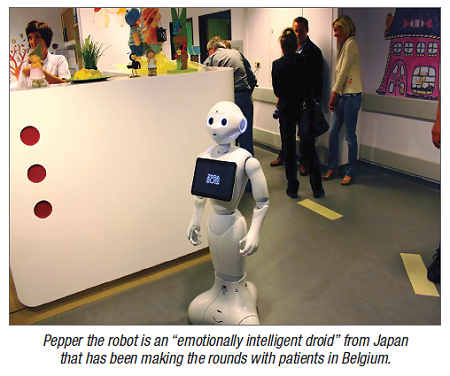But Is Their Handwriting Legible?
Virtual medical assistants a la Siri and Alexa are being used to assist doctors with clinicals by responding to, organizing, and easily accessing patient records and test results. Dragon Medical Virtual Assistant assists doctors in reading patient records and charts (“Nuance Rolls Out New AI Virtual Assistant for Healthcare,” Bill Siwicki, Sept. 27, 2017; healthcareitnews.com/news/nuance-rolls-out-ai-virtual-assistant-healthcare). Virtual assistants free up doctors to focus solely on patients instead of fumbling through multiple folders and piles of patient paperwork.
There is even AI available to help doctors communicate and explain patient’s lab results. Created by a Belgian inventor, Doc.ai will take communicating and educating patients on test results out of a doctor’s hands using AI. Via an app, Doc.ai explains lab results by asking the patient a series of questions and will provide the patients with results through pre-programmed response algorithms (“Scanadau Founders New Project Doc.ai Is a Conversational Robot That Explains Lab Results,” Jonah Comstock, Aug. 25, 2017; healthcareitnews.com/news/scanadu-launches-new-project-using-conversational-robot-explain-lab-results). It will also calculate results and interpret them much faster than a doctor would be capable of doing, once again freeing up doctors for more important tasks such as prescribing methods of treatment. AI uses its ability to learn and relay information to relieve doctors of smaller tasks and interactions that could possibly spread them too thin. When used in combination with healthcare providers, AI is a valuable tool in providing efficient, accurate, and effective care.

Humanoid Robots and Patient Interactions
But what about artificially intelligent robots, the popular branch of this technology? Are there robots out there that can walk around, interact with patients, and basically take the place of living, breathing medical care providers? The answer is, “Somewhat.” As of right now, we do not have robot doc tors, but we are striving to create something very similar to a doctor to assist them in healthcare facilities. Pepper is a humanoid robot programmed to “understand” human emotions and interactions. As of June 2016, Pepper has been part of the reception area in several Belgian hospitals, greeting patients and accompanying them to the appropriate department. The humanoid robot understands 20 languages and distinguishes between male, female, and child patients. Since Pepper understands human emotions, it can offer responses based on subject’s mood, such as affirming statements and reacting to jokes, even eventually learning different types of humor.
Developed in Japan, this is the first time Pepper has appeared in hospitals. In the past, Pepper worked in retail stores, and even sat beside students in class learning the lesson along with them. Pepper has relatives like the smaller NAO, used to help children become less afraid of hospitals and treatments and become more interested in exercise and healthy lifestyle choices. Pepper also functions as a “comfort robot,” offering emotional therapy for patients suffering from mental health illnesses (“Pepper Robot to Work in Belgium Hospitals,” June 14, 2016; bbc.com/news/technology-36528253).
Robot arms that are 100 times more accurate than any surgeon could be; virtual medical assistants that work harder, quicker, and more efficiently than a trained human counter par; and now droids who are programed to be “emotionally literate.” Where do we, the people and caregivers, fit in?! There is a common thread throughout all the AI, robotics, and AI robots used in healthcare—the need for a healthcare professional with human reaction times and knowledge to properly utilize this technology.
The robotics that make surgeries so successful enhance a human surgeon’s capabilities; virtual medical assistants complete the mundane aspects of charts and analyzing results so doctors can focus on treatment and research; and droids in hospitals perform functions that are still one step removed from directly diagnosing, and treating a patient. So while automation does pose a threat to change the industry, and some job loss will occur—perhaps those such as medical assistants or caregivers—there is still a need for a human healthcare professional’s judgment skills to operate the technology in order to deliver quality healthcare to patients.